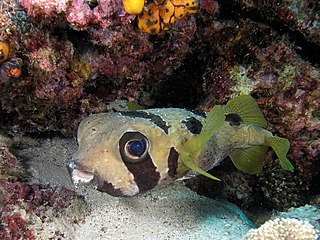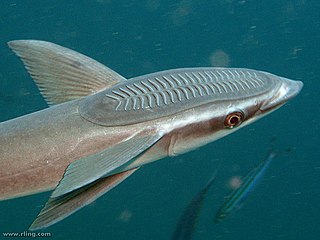
The remora, sometimes called suckerfish, is any of a family (Echeneidae) of ray-finned fish in the order Carangiformes. Depending on species, they grow to 30–110 cm (12–43 in) long. Their distinctive first dorsal fins take the form of a modified oval, sucker-like organ with slat-like structures that open and close to create suction and take a firm hold against the skin of larger marine animals. The disk is made up of stout, flexible membranes that can be raised and lowered to generate suction. By sliding backward, the remora can increase the suction, or it can release itself by swimming forward. Remoras sometimes attach to small boats, and have been observed attaching to divers as well. They swim well on their own, with a sinuous, or curved, motion.

The cobia is a species of carangiform marine fish, the only extant representative of the genus Rachycentron and the family Rachycentridae. Its other common names include black kingfish, black salmon, ling, lemonfish, crabeater, prodigal son, codfish, and black bonito.

The sharpnose sevengill shark, also known as one-finned shark, perlon shark, sevengill cow shark, sharpsnouted sevengill or slender sevengill, is a species of shark in the family Hexanchidae, and the only living species in the genus Heptranchias. Found almost circumglobally in deep water, it is one of the few species of sharks with seven pairs of gill slits as opposed to the usual five. The other shark species with seven gill slits is the broadnose sevengill shark. Though small, this shark is an active, voracious predator of invertebrates and fish. When caught, this species is notably defensive and will attempt to bite. It is of minor commercial importance.

Dactyloptena orientalis, known commonly as the Oriental flying gurnard or purple flying gurnard among other vernacular names, is a species of marine fish in the family Dactylopteridae. Their name is derived from the French word 'gurnard' meaning to grunt, for the grunting sound this fish makes.
The whalesucker is a species of remora in the family Echeneidae, so named because it attaches itself exclusively to cetaceans. It is found worldwide in tropical and warm waters; in the Gulf of Mexico and western Atlantic Ocean, it occurs from Texas to Brazil, and in the eastern Pacific Ocean, it occurs from Vancouver Island to Chile. It is the rarest member of the remora family, though this may reflect more the uncommon collection of cetaceans in the wild rather than the whalesucker's actual abundance.

The slender suckerfish or lousefish is a rare species of remora found around the world in tropical and subtropical seas, in areas like the Atlantic, Pacific, and Indian Ocean, from depths from 1 to 100 meters deep.
The spearfish remora is a species of remora with a worldwide distribution in tropical and subtropical seas. Remoras attach themselves to other fish with a sucker on the head and this fish is almost exclusively found living on billfishes or swordfishes, and sometimes on sharks.

The scrawled cowfish is a species of boxfish native to the western tropical and equatorial Atlantic, as well as the Gulf of Mexico. They range in size from 8–15 inches (20–38 cm), with a maximum length of 18 inches (46 cm), and can be found at depths between 6 and 80 feet. It is common to occasional in Florida and Bahamas; occasional to uncommon in the Caribbean. It also occurs in the Gulf of Mexico, north to Massachusetts, Bermuda and south to Brazil in tropical and warm temperate waters.

The giant trevally, also known as the lowly trevally, barrier trevally, ronin jack, giant kingfish, or ulua, is a species of large marine fish classified in the jack family, Carangidae. The giant trevally is distributed throughout the tropical waters of the Indo-Pacific region, with a range stretching from South Africa in the west to Hawaii in the east, including Japan in the north and Australia in the south. Two were documented in the eastern tropical Pacific in the 2010s, but whether the species will become established there remains to be seen.

The black-blotched porcupinefish, also known as shortspine porcupinefish, is a member of the family Diodontidae. It is found in the tropical and subtropical waters of the Indo-Pacific on coral and rocky reefs and in inshore waters. Other names are the blotched porcupinefish and the brown-backed porcupinefish.

The spot-fin porcupinefish, also known as the spotted porcupinefish, black-spotted porcupinefish or simply porcupinefish, is a member of the family Diodontidae.
The white suckerfish or mantasucker is a species of remora in the family Echeneidae, a group of elongated marine fish with adhesive discs for attaching to larger organisms. The distribution of this species is worldwide in warm open seas: it is found in the western Indian Ocean including Réunion and Mauritius, in the eastern Pacific Ocean from San Francisco to Chile, and in the western and eastern central Atlantic Ocean from Florida and the Gulf of Mexico to Brazil and St. Paul's Rocks.

The roughtail stingray is a species of stingray in the family Dasyatidae, with separate populations in coastal waters of the northwestern and southwestern Atlantic Ocean. This bottom-dwelling species typically inhabits sandy or muddy areas with patches of invertebrate cover, at a depth of 15–50 m (49–164 ft). It is seasonally migratory, overwintering in offshore waters and moving into coastal habitats for summer. The largest whip-tail stingray in the Atlantic, the roughtail stingray grows up to 2.6 m (8.5 ft) across and 360 kg (800 lb) in weight. It is plain in color, with an angular, diamond-shaped pectoral fin disc and a long, whip-like tail bearing a subtle fin fold underneath. The many thorns on its back and tail serve to distinguish it from other stingrays that share its range.

The cocinero, also known as the barred jack and striped jack, is a species of small marine fish classified in the jack family, Carangidae. The cocinero is distributed through the tropical eastern Pacific Ocean, ranging along the west American coastline from Baja California in the north to Peru in the south. It is a pelagic species, inhabiting the upper water column in both coastal and offshore oceanic waters, occasionally making its way into estuaries. The species may be identified by its colouration, having 8 or 9 incomplete dark vertical stripes on its sides, with scute and gill raker counts also diagnostic. It is small compared to most other species of Caranx, reaching a length of 37 cm in total. The cocinero is a predatory fish, taking small fishes, crustaceans, and various benthic invertebrates in shallower waters. Little is known of the species' reproductive habits. The cocinero is of moderate importance to fisheries along the west coast of South America, and the species has been used in aquaculture trials. It is taken by various netting methods and by spear, and is sold fresh, dried, and salted at market.

The common remora is a pelagic marine fish belonging to the family Echeneidae. The dorsal fin, which has 22 to 26 soft rays, acts as a suction cup, creating a vacuum to allow the fish to attach to larger marine animals, such as whales, dolphins, sharks, and sea turtles.

Echeneis is a genus of fish in the family Echeneidae, the remoras. The genus is distributed in the Atlantic, Pacific and Indian Oceans.

The marlin sucker or spear-fish remora is a species of remora found all over the world in tropical and temperate seas. It can reach up to 40 cm (16 in) in standard length. It normally lives attached to a larger fish; its host preference is for marlins and sailfishes, but it will attach to other large fish.

The whitefin sharksucker or short-disk sharksucker, is a species of remora native to subtropical waters of the western Atlantic Ocean, Gulf of Mexico and Caribbean Sea. This fish can reach a length of 75 centimetres (30 in) TL though most fish do not exceed 50 centimetres (20 in) TL. It can be free-swimming, or can attach itself to a host fish or turtle by means of a sucker on the back of the head.

The longrakered trevally, also known as the cale cale trevally and heavyjawed kingfish, is a species of marine fish in the jack and horse mackerel family Carangidae. The longrakered trevally is distributed throughout the tropical and subtropical waters of the Indian and west Pacific Oceans, from Mozambique and Madagascar in the west, to Japan and northern Australia in the east. A large species growing to a recorded length of 1 m, the longrakered trevally is distinguished by is protruding lower jaw, elongated gill rakers and lack of villiform teeth on its tongue. It is an inshore species, restricted to coastal and estuarine regions, where it preys on fishes and crustaceans. Little is known of the species reproductive cycle or growth. The longrakered trevally is of minor importance to fisheries and is often taken as bycatch in finfish and prawn trawls, as well as by recreational fishermen.

The black pomfret is a species of carangid native to reefs of the Indian Ocean and western Pacific Ocean. This species is very important to local fisheries and is the only known member of its genus.


















